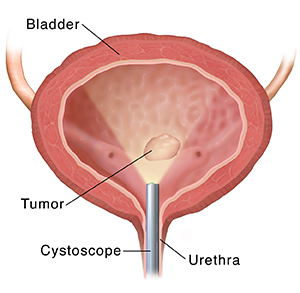Treating Bladder Cancer: Transurethral Resection (TUR)
Treating Bladder Cancer: Transurethral Resection (TUR)

Cystoscopy is a way for your healthcare provider to get a close look at the inside of your bladder. A thin tube with a camera on it is passed through your urethra and into your bladder. This tube is called a cystoscope or resectoscope. Problems of the urinary tract can be found and sometimes treated with cystoscopy.
If cancer is found and it's in an early stage and is growing slowly (low grade), it may be taken out during cystoscopy. This is called a transurethral resection (TUR) or transurethral bladder resection (TURBT). The whole procedure is done through the scope. No cut is made in your skin.
Most of the time, tissue taken out during TUR will be tested to see exactly what it is and if more treatment is needed.
Before cystoscopy
TUR is most often done in a hospital as an outpatient procedure. If the tumor is large, you may stay overnight.
You'll be given medicine so you don’t feel pain during the procedure. This is called anesthesia. If you have regional anesthesia, just the lower part of your body is numbed. Medicine may also be used to make you feel sleepy. If you have general anesthesia, you'll be in a deep sleep throughout the procedure.
During the procedure
A cystoscope or resectoscope is passed through your urethra and into your bladder. The lining of the bladder is looked at through the scope. If tumors are found, they are taken out if possible. A cutting tool is put in through the scope to do this. Electricity might be used to seal off blood vessels.
A sample of cells (biopsy) from the tumor and normal-looking tissue may be taken. These samples are looked at under a microscope. This is done to look for cancer and, if it's found, to see how deeply it has grown into the bladder wall. In some cases, a laser is then used to burn any remaining tumor away.
After the procedure
Here is what to expect after TUR:
-
After the procedure, a thin, flexible tube (catheter) might be put in your bladder. This drains urine and blood out of your bladder while you heal. The tube may stay in for a few days.
-
Bladder tumors can come back (recur) after treatment. To be sure that all cancer cells are killed, TUR may be followed by other types of treatment, such as intravesical therapy. This puts special medicine in the bladder to kill the cancer cells.
- TUR might be done again if the biopsy shows that all the cancer cells weren't taken out.
Risks and possible complications of TUR
All procedures have risks. Risks of TUR include:
-
Blood or blood clots in the urine
- Bladder spasms and irritation
-
Pain when passing urine
-
Urinary frequency (having to go more often than usual)
Make sure you know what to watch for and when to call your healthcare provider. Know how to reach your healthcare provider after office hours and on weekends.
Updated:
September 09, 2019
Reviewed By:
Raymond Kent Turley BSN MSN RN ,Kimberly Stump-Sutliff RN MSN AOCNS,Lu Cunningham RN BSN